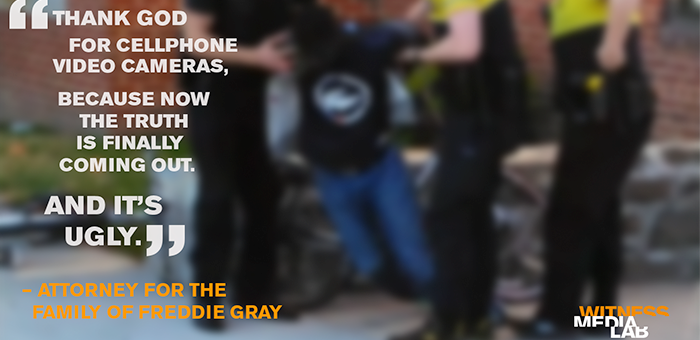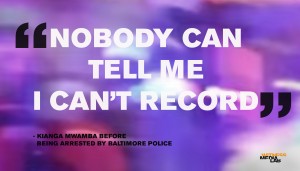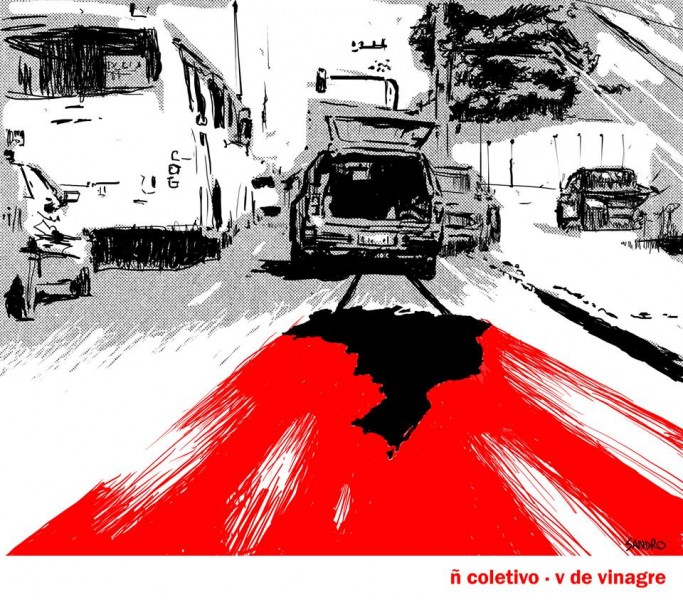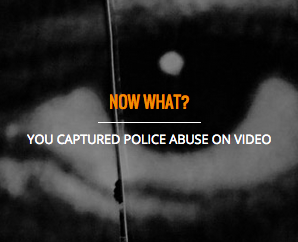Published September, 2015 by WITNESS in Right to Record, United States, Update
Caught on Camera: Police Abuse in the U.S.
By Madeleine Bair
During her night in a Baltimore jail, 36-year-old Kianga Mwamba held out hope that one thing would prove her innocence: her cellphone video.
It was March of 2014. Driving home late at night, Mwamba saw police beat a man in handcuffs and began filming out her car window. Next thing she knew, she became the target: forced out of her car, tasered, and charged with attempting to run over an officer. Her smartphone recorded it all.
But when Mwamba was released from jail and given her belongings, the video was no longer there.
In the past year, one horrific cellphone video after another has put a spotlight on police brutality, militarized law enforcement, and systemic racism–bringing injustice that has long affected black and brown communities in the U.S. to the attention of the mass media, politicians, and society. “Thank god for cellphone video cameras,” Baltimore attorney William Murphy Jr. said after the killing of Freddie Gray. “Because now the truth is finally coming out. And it’s ugly.”
The story of Kianga Mwamba, however, forces us to ask, how does the truth come out? With all the videos that have flooded our news feeds and turned names of victims into hashtags of a social movement, how many videos have we not seen? How many cases have not caught the public’s attention because there was no video? Because the video was confiscated or destroyed? Because the filmer was afraid to share the footage? Or because the video was not as clear and shocking as that of the killing of Walter Scott?
There are no clear answers to these questions. But given the central role attributed to video in the national dialogue about injustice and reform, it is important to examine exactly how that video is coming out, what are its limitations, and how it can be leveraged even more effectively as a tool for justice.
In the summer of 2015, the WITNESS Media Lab took a close look at the role of video in promoting awareness and accountability for abuse–both in cases that have reached national attention and in others that have not.
In Mwamba’s case, the truth did come out, thanks to a phone setting Mwamba was unaware of that had automatically backed up the video of her arrest. It led to the dropping of charges against her, but Mwamba wants to see disciplinary action against the officers who tasered and arrested her and falsely reported the incident. Despite the video, thus far she’s seen nothing.
Our survey of four cases in the U.S.–and several from around the world–challenge assumptions about the role of video in attaining accountability for abuse, and point to ways filmers, advocates, journalists, and the justice system can use video more effectively for change. Read on for more on Mwamba’s arrest and other stories of police abuse, as well as what they tell us about strategies for using video effectively, the role of media and technology in attaining awareness and accountability, and the many ways that videos are making an impact.
Cases
Phillip White
Phillip White was unarmed when he was approached by Vineland, New Jersey, police officers. The encounter, caught on video by two anonymous bystanders, included officers attacking him with a canine while White appeared to be unconscious. After arresting him, officers took White to a hospital, where he was declared dead.
Kianga Mwamba
Mwamba was stopped at a red light in Baltimore when she began filming what she has described as police officers beating a handcuffed man. Officers forced her out of the car, tasered her, and charged her with intending to run over an officer. After spending a night in jail, Mwamba received her cellphone, and footage of the incident was no longer there. After retrieving it from her Google account, she showed it to authorities and her charges were dropped.
Askia Sabur
Askia Sabur and his cousin were approached by Philadelphia police and asked to clear the corner where they were standing outside a restaurant. After they told officers they were waiting for food, the situation escalated. Officers forced Sabur to the ground, and one beat him repeatedly with a steel baton, leaving him with a fractured arm and head wounds that would take staples to close. Videos shot from a bystander served as evidence of the officers’ false testimony and eventually cleared Sabur of all charges.
Walter Scott
Walter Scott was pulled over for a broken brake light in North Charleston, South Carolina. While Officer Michael Slager was running a report, Scott opened his car door and ran. A bystander recorded Slager shoot Scott eight times in the back as Scott ran away, and then place an object beside Scott’s body. The video was shared on national news, exposing lies in officer Slager’s police report. Immediately following the video’s release, Slager was arrested and charged with murder.
Analysis
These four cases illustrate a range of ways bystander videos are released to the public–as well as the barriers that could have kept them from emerging at all. It is impossible to pinpoint with certainty the role that the eyewitness footage played in each case in attracting media attention, contributing to advocacy efforts, and resulting in the legal ramifications or policy reforms that followed or are still underway. Too many factors are involved in each case to draw those sorts of conclusions. What we can say is that the issues illustrated by these cases are not unique, and within these stories of tragedy and abuse are valuable lessons for filmers, advocates, and others who seek to use video to advance truth, justice, accountability, and reform.
What IS the Connection Between Video and Impact?
Thanks to video, Baltimore attorney William Murphy Jr. said, “the truth is finally coming out.” But whether or not that truth leads to accountability is a different story, and often a disappointing one. The use of the video by the media and the justice system often depends as much on the profile of the victim, the strategy of grassroots activists, the timing of the video’s emergence, the legal strategy of the victim’s lawyers, and the individual decisions of local police chiefs, judges, and prosecutors, as it does on the quality of the video itself and the abuse it documents. We know Feidin Santana’s cellphone video impacted the response of South Charleston authorities who pressed charges against the officer who killed Walter Scott. What we’ll never know is how much of a factor the videos of Eric Garner, Michael Brown, and Freddie Gray also contributed to their response.
“I think those events were adequately captured. It’s just very difficult to get these people to pay criminally for their conduct.” -Stanley King
No matter how clear and abundant evidence may be, it is important to recognize the limitation of video evidence within political structures and legal systems that are historically biased toward law enforcement officers. Stanley King, the lawyer representing the family of Phillip White, told WITNESS the bystanders who filmed White’s arrest “did the right thing as far as their ability to document and record the event they saw taking place.” He pointed to the eyewitness videos of Rodney King and Eric Garner as two cases in which police officers were not held accountable for abuse, despite the public attention and video evidence. “I think those events were adequately captured. It’s just very difficult to get these people to pay criminally for their conduct.”
When video is used in an investigation, it is used most effectively to acquit a civilian of bogus charges. However, even when the video documents excessive force, reveals false reporting by police, exposes the tampering of evidence, or other police misconduct, it is not necessarily used by investigating authorities to discipline officers or motivate reform.
In the case of Kianga Mwamba, for example, though the video resulted in the dropping of charges against her, the Maryland State’s Attorney’s Office has yet to indicate whether any disciplinary measures will result from its investigation into the officers who arrested her a year and a half ago. Askia Sabur, too, was acquitted after video of his arrest was presented at a juried trial. But even after the trial was over, the police department had yet to determine whether the officers’ physical abuse, destruction of a camera, intimidation of bystanders, false reporting, or any of the other abuses the trial and footage brought to light involved misconduct.
Impact in Other Ways
While it is impossible to attribute press attention, reform efforts, and shifting attitudes towards law enforcement practices to any one particular factor, it is important to recognize the impact of videos–individually and cumulatively–in these critical steps toward justice.
In New Jersey, the attorney general released a directive this summer providing guidelines for greater transparency and independence when investigating fatal police encounters. No longer, for instance, can a grand jury decide not to indict an officer without publicly sharing the findings of the investigation. Whether this directive, and a new policy equipping New Jersey officers with body cameras, resulted in part due to the deaths of Phillip White, Alissa Allen, and Jerame Reid, the nationwide conversation about law enforcement fueled by bystander videos has produced reforms at the local, state, and federal level.
Press attention fueled by video has also led to greater scrutiny of law enforcement, revealing abuses and patterns beyond what is seen on camera. For instance, following the death of Phillip White, the Latino Leadership Alliance of New Jersey published a study of use of force (UOF) reports in Cumberland County, which revealed that the two police officers involved in White’s death were among the top officers in filing UOF complaints in the past several years. After the video of Askia Sabur’s arrest came out, a reporter found that two of the officers involved there had been accused multiple times of physical abuse.
The collective impact of videos documenting a pattern of abuse against black and brown communities is perhaps the most difficult to determine. Will it alter perceptions of police tactics among politicians? Lead to a greater willingness of juries to doubt an officer’s testimony? Rich Rivera of the Latino Leadership Alliance of New Jersey told WITNESS it’s hard to point to examples of video leading to accountability in any specific case of abuse. But, he said, “there is a cumulative response. Garner didn’t make a difference in New York City, but there are collaterals.” We know Feidin Santana’s cellphone video impacted the response of South Charleston authorities who pressed charges against the officer who killed Walter Scott. What we’ll never know is how much of a factor the videos of Eric Garner, Michael Brown, and Freddie Gray also contributed to their response.
(There are interesting parallels in Brazil, where videos by favela residents are not only leading to disciplinary action in particular cases, but also collectively, a shift in the way mainstream media and politicians talk about police violence in favela communities. Read this article by WITNESS’s Priscila Neri for more.)
Through archival initiatives, bystander videos of police abuse and the Black Lives Matter protest movement are contributing to not only contemporary debates and legal investigations, but a collective memory for future generations. By archiving online reports by citizens and activists, projects like Documenting Ferguson and Preserve the Baltimore Uprising are ensuring that these online records of the experiences of African American communities are shared and preserved.
Where, When & How a Video is Released
When we say a specific outcome resulted from video, what we usually mean is that an outcome resulted from the fact that the video was seen. Mass media attention can help attract that audience–as can online and offline social movements.
The cases of Kianga Mwamba and Phillip White are examples of violent police encounters caught on video that received relatively little sustained attention by national media or advocacy groups. (Take a look at the blogs Photography Is Not a Crime or VICE’s Officer Involved to see others from across the country on a daily basis.)
Would South Charleston officer Michael Slager have been arrested for the killing of Walter Scott if there had not been video? Probably not. Would Slager have been arrested if the video had not been released on the front page of the New York Times? That is more difficult to say. While the circumstances and footage are completely different, it bears noting that Phillip White’s fatal encounter with police in New Jersey took place just days before Scott’s, and his family is still awaiting an autopsy report and results of the official investigation.
In addition to how footage is distributed, the timing of its release can affect its potential for impact. The videos of Askia Sabur and Walter Scott emerged after police reports were filed, precluding officers from shaping their report in response to what is in the footage and exposing clear contradictions that undermine the officers’ credibility.
Understanding the potential impact of where, when and how a video is shared can inform guidance for citizen journalists unsure of what to do after filming abuse. Feidin Santana told the media that he was confounded, scared, and stressed, nearly to the point of not releasing his recording of Officer Slager shooting Walter Scott. Drawing from lessons learned from these and other cases, we have put together guidelines to help bystanders navigate the questions Santana faced. Step one: pause and think. (It’s less obvious than it sounds.) Click here for the tips.
Assert Your Right to Record
Filming the police carrying out their duties is a constitutional right, and officers may not confiscate or demand to view your digital footage without a warrant. It’s worth stating because so many videos of police encounters show law enforcement infringe upon this right, causing us to wonder how many videos of abuse have not been filmed or released because bystanders were intimidated, fearful, or arrested for the act of filming.
In the Askia Sabur case, almost as disturbing as the footage of his beating is what is recorded afterwards: with a metal baton in hand, Officer Jimmy Leocal approaches the filmer, who steps back and holds the camera away from Leocal’s reach. Other officers later approach him as a group. If the filmer had not asserted his right to record, the footage could have wound up like that of the second filmer who was arrested on the scene and whose camera was destroyed. Same goes for witnesses to the fatal arrest of Phillip White. “I’m gonna take your phone,” an officer said to a filmer. “We’re gonna take it for evidence.” The witness responds, “I want it for evidence,” and it was shared online days later.
For more on asserting your right to film police, see this list of resources from a variety of civil rights organizations.
Smart Strategies & Functions of Mobile Technology
Mobile technology has been key to equipping more people in more places to film abuse. The fact that most of us in the United States have a camera in our pocket with the ability to record video and share it with the world means we’re ready to film at any moment. Right?
Not quite. The case of Kianga Mwamba illustrates just how vulnerable our mobile videos are. Mwamba alleges that her video was deleted from her phone’s video gallery when she was in jail. Potential confiscation of your phone is just one way footage could be compromised. A phone could also be destroyed, intentionally or not, in the chaos of a protest or violent encounter.
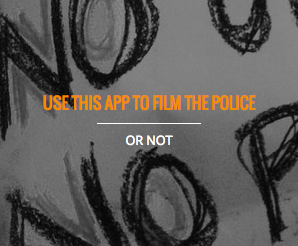 A function that automatically backs up footage is what saved Mwamba’s from being erased–and what led to the dropping of charges against her. Click here for ways to consider securing your device and its footage so that, if and when you find yourself witness to abuse, you are prepared to hit record.
A function that automatically backs up footage is what saved Mwamba’s from being erased–and what led to the dropping of charges against her. Click here for ways to consider securing your device and its footage so that, if and when you find yourself witness to abuse, you are prepared to hit record.
While a number of apps have been developed specifically for filming police encounters, most bystanders will want to use a tool they are familiar with using every day. Filming with your phone’s native camera app is the best way to ensure you have options for how, where and when to share and preserve the footage, rather than be forced to share it immediately and on a particular website or social media platform.
There’s one more aspect of mobile technology that Mwamba’s case brings to light: the value of metadata. Attempting to delete footage from her phone while she was in jail would constitute a federal offense, but Mwamba’s attorney, Kerri Cohen, explained to WITNESS that because that would be difficult to prove, it was not included in Mwamba’s lawsuit against Baltimore police. If metadata were more easily accessible for the average user, they would have a better chance of proving exactly when the video was deleted.
It is important to bear in mind, as we consider the potential impact of bystander videos, that what is caught on camera is usually a flashpoint of injustices that take place over years, not moments, and between communities and political structures, not two or three individuals. The video of Michael Brown’s body in a Ferguson street shined a spotlight on the police killing of an 18-year-old black man in August, 2014. Over time and due to mass protests and grassroots organizing, that spotlight expanded, turning the attention of the media and political leaders to issues that cannot be easily captured in amateur videos–issues like school segregation, municipal fines, and racially biased policing. As more people are willing and prepared to take out their cameras and document their communities and the injustices they face, we’ll move closer as a society to addressing individual cases of abuse as well as the deeper questions of law enforcement, violence, and inequality in this country.
Morgan Hargrave, Jackie Zammuto, and WITNESS Media Lab intern Allison Walker contributed to this report.
Click here for more from the WITNESS Media Lab on citizen videos and police abuse in the U.S. Share your thoughts with us @WITNESS_Lab.

